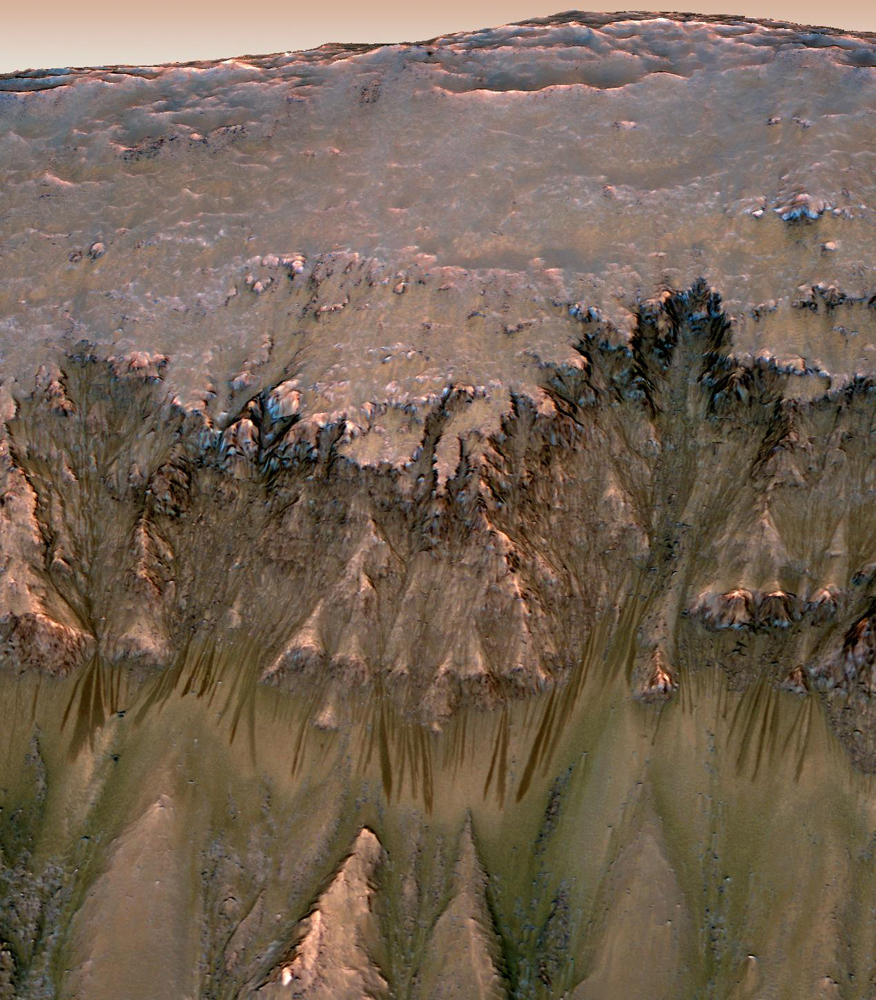Hints of Water Spark Fresh Hope for Life on Mars

The evidence of possible liquid water on Mars, announced today (Aug. 4), has scientists newly excited about the Red Planet's potential to host some form of primitive life, scientists say.
The discovery comes from the Mars Reconnaissance Orbiter (MRO), which spotted slopes carved into the Martian surface that appear to most likely have been created by the flow of liquid salt water, NASA announced today (Aug. 4). The slopes appear to change over the course of different seasons on Mars, suggesting that liquid water, if it exists at all, is only present in the Martian spring.
In recent years, evidence has been mounting that Mars has icecaps of frozen water at its poles, but the new discovery is the strongest hint yet that liquid water may also exist on the Martian surface, scientists said. [Photos: The Search for Water on Mars]
"It hasn't been a question for some time now that there's ice on Mars," geophysicist Philip Christensen of Arizona State University in Tempe said today during a NASA press conference. "What makes these new observations so interesting is that they occur at much lower latitudes where temperatures are much warmer and where it's actually possible for liquid water to exist."
Liquid water is the Holy Grail for scientists hunting for life beyond Earth. All life on this planet relies on liquid water, and experts think extraterrestrials likely do, too. And Mars, as the planet next in line after Earth from the sun, is one of the top potential habitats for ET.
"I think this is an eye-opening discovery that will really help us begin the planning process for future missions specifically looking for signs of the presence of life on Mars," biogeochemist Lisa Pratt of Indiana University at Bloomington said.
In addition to the ice caps on Mars, previous studies have also hinted at the presence of liquid water beneath the surface. Though this water, too, could possibly nurture microscopic life, we have little way of looking for it there, hidden deep underground. [Video: Did Mars Make Life, And Lose It?]
Get the Space.com Newsletter
Breaking space news, the latest updates on rocket launches, skywatching events and more!
The new discovery, however, offers the tantalizing hope that life might exist on Mars' surface, and thus, signs of its presence, such as the release of biologically produced chemicals, could be visible to us.
"It is our first chance to see an environment on Mars that might allow for the expression of an active biological process if there is presently life on Mars," Pratt said.
Pratt suggested looking for chemically produced gases such as methane or hydrogen sulfide, or oxidized gas such as oxygen.
The closest analogue on Earth to the salty, briny water possible on the slopes of Mars is the Siberian permafrost, Pratt said. While that's not exactly heaven for creepy crawlies, certain brands of hardy extremophile microbes are known to thrive there. [FAQ: What the Possibility of Water on Mars Means]
And if it works in Siberia, why not on Mars?
Before getting too excited about finding ET on the Red Planet, though, scientists cautioned that more observations and experiments are needed to confirm the water's presence.
"We have this circumstantial evidence for water flowing on Mars," said Alfred McEwen, a planetary geologist at the University of Arizona, Tucson. "We have no direct detection of water."
Still, scientists now have a better idea where to focus their searches for liquid water, and life, on Mars.
"For me, this is sort of the beginning of the scientific process here we've just started," Christensen said. "There's questions regarding these observations, but now the scientific community can really turn to them and really begin to probe the details of what these observations are telling us."
You can follow SPACE.com senior writer Clara Moskowitz on Twitter @ClaraMoskowitz. Follow SPACE.com for the latest in space science and exploration news on Twitter @Spacedotcom and on Facebook.
Join our Space Forums to keep talking space on the latest missions, night sky and more! And if you have a news tip, correction or comment, let us know at: community@space.com.

Clara Moskowitz is a science and space writer who joined the Space.com team in 2008 and served as Assistant Managing Editor from 2011 to 2013. Clara has a bachelor's degree in astronomy and physics from Wesleyan University, and a graduate certificate in science writing from the University of California, Santa Cruz. She covers everything from astronomy to human spaceflight and once aced a NASTAR suborbital spaceflight training program for space missions. Clara is currently Associate Editor of Scientific American. To see her latest project is, follow Clara on Twitter.









